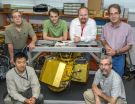(Press-News.org) A Mayo Clinic task force challenges some recommendations in the updated guideline for cholesterol treatment unveiled by the American College of Cardiology (ACC) and American Heart Association (AHA) in 2013. The task force concludes, based on current evidence, that not all patients encouraged to take cholesterol-lowering medications, such as statins, may benefit from them and that the guideline missed some important conditions that might benefit from medication.
Furthermore, the task force believes an emphasis needs to be placed on an individualized treatment approach with each patient and exercising shared decision-making.
Recommendations of the task force, made up of Mayo Clinic experts in cardiology, endocrinology and preventive medicine, with no conflicts of interest or links to the drug industry, will be published Aug. 14 in Mayo Clinic Proceedings. An editorial will accompany the paper. Mayo Clinic physicians are adopting the task force's guideline.
"The ACC/AHA cholesterol guideline was last updated in 2001, so it needed to be updated. We agree with many points of the guideline, but there are some key areas where we do not completely agree or we wanted to expand and provide more guidance," says Francisco Lopez-Jimenez, M.D., task force chairman and director of preventive cardiology at Mayo Clinic in Rochester, Minnesota.
Mayo's cholesterol treatment recommendations challenge some core ACC/AHA recommendations, and go further in-depth in some areas. For example:
* The ACC/AHA cholesterol treatment guideline recommends prescribing the strongest statins at high doses to most men older than 65, even those with no history of heart disease, or any major risk factor for heart attacks, and with normal cholesterol levels. Men this age will be classified as high risk only on the basis of age. The Mayo task force found no evidence from clinical trials to recommend treating people only on the basis of age in the absence of risk factors, high cholesterol or inflammation.
* The ACC/AHA cholesterol treatment guideline recommends cholesterol-lowering medication as a primary preventive measure against cardiovascular disease, and encourages health care providers to simultaneously emphasize the importance of healthy lifestyle habits. The Mayo task force encourages lifestyle changes — such as exercise and dietary changes — first, followed by re-evaluating risk in three to six months before prescribing statins, especially in motivated patients and with borderline high risk.
* The ACC/AHA cholesterol treatment guideline recommends statins for all people with diabetes mellitus who are 40 years or older. The Mayo task force debunks the concept that all diabetics have the same risk as people with history of heart attacks. The Mayo task force does not recommend in favor of or against the use of statins in patients with diabetes in whom the risk for heart attacks or stroke is low based on the calculator proposed by the ACC/AHA.
In addition, Mayo's task force recommends statins to patients with some conditions that the ACC/AHA guideline did not specifically address, such as patients who have rheumatoid arthritis, recipients of a kidney or heart transplant or those infected with the AIDS virus. These patients are known to have an increased risk of heart attack, Dr. Lopez-Jimenez says.
Second Mayo Clinic task force examined cardiovascular risk assessment guideline
A second Mayo Clinic task force provided a perspective on the new ACC/AHA guideline for assessing cardiovascular risk in patients who do not have heart disease, also released in 2013. The panel recognizes the value of several new features in the guideline, such as specific risk equations for African-Americans, equations to calculate both 10-year and 30-year lifetime risk, inclusion of stroke as an adverse cardiovascular event, and emphasis on shared decision-making.
These recommendations also are published in a second paper Aug. 14 in Mayo Clinic Proceedings.
But there are areas where Mayo's risk assessment task force recommended adaptation of the ACC/AHA's recommendations. For example, the ACC/AHA guideline suggests using family history only when a "risk-based treatment decision is uncertain," says Iftikhar Kullo, M.D., Mayo Clinic cardiologist and chair of the risk assessment task force.
"We recommend that family history should be obtained at the time of estimating cardiovascular risk using the new equations," Dr. Kullo says. "Many studies have shown family history to be an independent predictor of cardiovascular risk. Obtaining family history may also help to identify additional individuals in a family who may be at risk."
Mayo's task force highlights caveats in the use of ankle-brachial index and C-reactive protein for cardiovascular risk assessment — two tests recommended by the ACC/AHA guideline — and recommends that the following additional tests could be considered to refine estimates of cardiovascular risk:
* An ultrasound test of the carotid (neck) arteries to measure thickness of the lining of the arteries, as well look for presence of plaque.
* A noninvasive test (aortic pulse wave velocity) to measure stiffness in the arteries.
* A blood test to measure lipoprotein(a), a type of LDL (or "bad") cholesterol. Lp (a) level is determined by genes, and high levels are associated with increased cardiovascular risk.
Both Mayo Clinic task forces also emphasized the importance of individualized care and using shared decision-making tools with patients to decide on treatment and determining heart disease risk. "We encourage an individualized approach, particularly when the evidence is inconclusive to a patient's particular situation," Dr. Lopez-Jimenez says. "In addition, we want to find a treatment — whether it's lifestyle changes or perhaps statins — the patient will follow through with because that is what will help make a difference in cardiovascular prevention."
INFORMATION:
About Mayo Clinic Proceedings
Mayo Clinic Proceedings is a monthly peer-reviewed medical journal that publishes original articles and reviews on clinical and laboratory medicine, clinical research, basic science research and clinical epidemiology. Proceedings is sponsored by the Mayo Foundation for Medical Education and Research as part of its commitment to physician education. Mayo Clinic Proceedings is among the most widely read and highly cited scientific publications for physicians. It has a circulation of 125,000 and receives submissions from authors worldwide. Published by Elsevier. Articles are available online at http://www.mayoclinicproceedings.org.
About Mayo Clinic
Mayo Clinic is a nonprofit organization committed to medical research and education, and providing expert, whole-person care to everyone who needs healing. For more information, visit http://www.mayoclinic.org/about-mayo-clinic or http://newsnetwork.mayoclinic.org/.
MEDIA CONTACT:
Traci Klein, Mayo Clinic Public Affairs, 507-284-5005, Email: newsbureau@mayo.edu
Mayo Clinic challenges some recommendations in updated cholesterol treatment guideline
2014-08-14
ELSE PRESS RELEASES FROM THIS DATE:
NSAIDs benefit overweight breast cancer patients, study finds
2014-08-14
AUSTIN, Texas — Researchers have determined that postmenopausal overweight or obese breast cancer patients receiving hormone therapy as part of their treatment and who use nonsteroidal anti-inflammatory drugs (NSAIDs) such as aspirin or ibuprofen have significantly lower breast cancer recurrence rates and a sizable delay in time to cancer recurrence.
The findings, published in the Aug. 14 edition of Cancer Research, suggest a new possibility for reducing the incidence of breast cancer recurrence among overweight and obese postmenopausal women, who have a comparatively ...
Scientists make major breakthrough in understanding leukemia
2014-08-14
Scientists from Queen Mary University of London (QMUL) have discovered mutations in genes that lead to childhood leukaemia of the acute lymphoblastic type – the most common childhood cancer in the world.
The study was conducted amongst children with Down's syndrome – who are 20-50 times more prone to childhood leukaemias than other children – and involved analysing the DNA sequence of patients at different stages of leukaemia.
The researchers uncovered that two key genes (called RAS and JAK) can mutate to turn normal blood cells into cancer cells. However, these ...
Can our computers continue to get smaller and more powerful?
2014-08-13
From their origins in the 1940s as sequestered, room-sized machines designed for military and scientific use, computers have made a rapid march into the mainstream, radically transforming industry, commerce, entertainment and governance while shrinking to become ubiquitous handheld portals to the world.
This progress has been driven by the industry's ability to continually innovate techniques for packing increasing amounts of computational circuitry into smaller and denser microchips. But with miniature computer processors now containing millions of closely-packed transistor ...
UT Arlington team's work could lead to earlier diagnosis, treatment of mental diseases
2014-08-13
A computer science and engineering associate professor and her doctoral student graduate are using a genetic computer network inference model that eventually could predict whether a person will suffer from bipolar disorder, schizophrenia or another mental illness.
The findings are detailed in the paper "Inference of SNP-Gene Regulatory Networks by Integrating Gene Expressions and Genetic Perturbations," which was published in the June edition of Biomed Research International. The principal investigators were Jean Gao, an associate professor of computer science and engineering, ...
Three radars are better than one: Field campaign demonstrates two new instruments
2014-08-13
Putting three radars on a plane to measure rainfall may seem like overkill. But for the Integrated Precipitation and Hydrology Experiment field campaign in North Carolina recently, more definitely was better.
The three instruments, developed by the High Altitude Radar group at NASA's Goddard Space Flight Center in Greenbelt, Maryland, flew as part of the Global Precipitation Measurement (GPM) mission's six-week ground-validation program that took place May 1 through June 15 in the southern Appalachians, specifically to measure rain in difficult-to-forecast mountain regions. ...
New material could enhance fast and accurate DNA sequencing
2014-08-13
CHAMPAIGN, Ill. — Gene-based personalized medicine has many possibilities for diagnosis and targeted therapy, but one big bottleneck: the expensive and time-consuming DNA-sequencing process.
Now, researchers at the University of Illinois at Urbana-Champaign have found that nanopores in the material molybdenum disulfide (MoS2) could sequence DNA more accurately, quickly and inexpensively than anything yet available.
"One of the big areas in science is to sequence the human genome for under $1,000, the 'genome-at-home,'" said Narayana Aluru, a professor of mechanical ...
Patent examiners more likely to approve marginal inventions when pressed for time
2014-08-13
CHAMPAIGN, Ill. — Haste makes waste, as the old saying goes. And according to research from a University of Illinois expert in patent law, the same adage could be applied to the U.S. Patent and Trademark Office, where high-ranking examiners have a tendency to rubber-stamp patents of questionable merit due to time constraints.
The less time patent examiners are given to review an application, the more likely they are to grant patent protection to inventions "on the margin," says a study co-authored by Melissa Wasserman, the Richard and Anne Stockton Faculty Scholar and ...
Bones from nearly 50 ancient flying reptiles discovered
2014-08-13
Scientists discovered the bones of nearly 50 winged reptiles from a new species, Caiuajara dobruskii, that lived during the Cretaceous in southern Brazil, according to a study published August 13, 2014 in the open-access journal PLOS ONE by Paulo Manzig from Universidade do Contestado, Brazil, and colleagues.
The authors discovered the bones in a pterosaur bone bed in rocks from the Cretaceous period. They belonged to individuals ranging from young to adult, with wing spans ranging from 0.65-2.35m, allowing scientists to analyze how the bones fit into their clade, but ...
Embalming study 'rewrites' chapter in Egyptian history
2014-08-13
The origins of mummification may have started in ancient Egypt 1,500 years earlier than previously thought, according to a study published August 13, 2014 in the open-access journal PLOS ONE by Stephen Buckley from University of York and colleagues from Macquarie University and University of Oxford.
Previous evidence suggests that between ~4500 B.C. and 3100 B.C., Egyptian mummification consisted of bodies desiccating naturally through the action of the hot, dry desert sand. The early use of resins in artificial mummification has, until now, been limited to isolated occurrences ...
Little penguins forage together
2014-08-13
Most little penguins may search for food in groups, and even synchronize their movements during foraging trips, according to a study published August 13, 2014 in the open-access journal PLOS ONE by Maud Berlincourt and John Arnould from Deakin University in Australia.
Little penguins are the smallest penguin species and they live exclusively in southern Australia, New Zealand, and the Chatham Islands, but spend most of their lives at sea in search of food. Not much is known about group foraging behavior in seabirds due to the difficulty in observing their remote feeding ...





